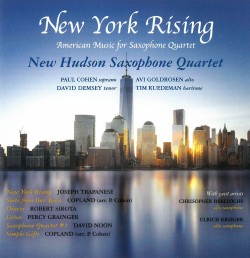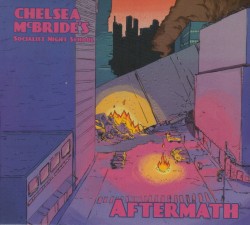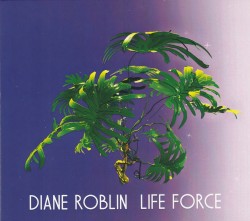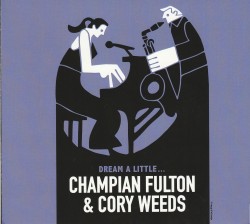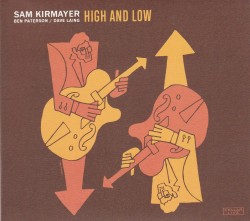Often called an orchestra on its own, the pianoforte has been an accepted vessel for solo performances almost from the time it was invented around 1700. Through the centuries its refinement and development has allowed for memorable presentations in jazz, so-called classical and less-refined popular music. Depending on the player and the program, the piano can be both a percussive and a melodic instrument so that its versatility can be emphasized by committed improvisers as well.
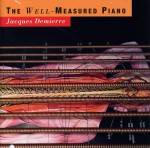 Jacques Demierre is one pianist with experience on both sides of the notated/improvised divide. He takes solo keyboard playing one step further on The Well-Measured Piano (Creative Works CW 1064 creativeworks.ch) by stretching three selections with selective overdubbing and editing. Unlike those who use these tools as gimmicks, Demierre’s conclusions about the acoustic properties and architectural construction of his instrument allow him to add more logical textures to his creations. While some of his variations can seem to be as stiff-necked and conventional as if he was interpreting a Romantic sonata, his basic strategy is to balance key patterning and string strumming so that low and high pitches are both highlighted. Additionally his pacing is such that he can be as energetic as necessary without losing forward motion. A track such as Wind Motet, for instance, begins with a tsunami-like eruption of internal string sweeps that are built up with keyboard clips and slathers. As the discordant waves-against-shoreline timbres intensify into swelling cacophony, a melodic line remains on top. Meanwhile, the stop-time exposition that is To Thank the Morning Rain is distinguished by elevated key scratches alongside a near-processional mid-range theme that encompasses sly rhythms and echoes, as the narrative gets busier and more concentrated. Climaxing with a pressurized, almost claustrophobic overlay, the track ends with tones ringing downwards into the soundboard. If preparations weren’t noted, the multiple textures might be attributed to prodigious skill rather than mechanical extensions.
Jacques Demierre is one pianist with experience on both sides of the notated/improvised divide. He takes solo keyboard playing one step further on The Well-Measured Piano (Creative Works CW 1064 creativeworks.ch) by stretching three selections with selective overdubbing and editing. Unlike those who use these tools as gimmicks, Demierre’s conclusions about the acoustic properties and architectural construction of his instrument allow him to add more logical textures to his creations. While some of his variations can seem to be as stiff-necked and conventional as if he was interpreting a Romantic sonata, his basic strategy is to balance key patterning and string strumming so that low and high pitches are both highlighted. Additionally his pacing is such that he can be as energetic as necessary without losing forward motion. A track such as Wind Motet, for instance, begins with a tsunami-like eruption of internal string sweeps that are built up with keyboard clips and slathers. As the discordant waves-against-shoreline timbres intensify into swelling cacophony, a melodic line remains on top. Meanwhile, the stop-time exposition that is To Thank the Morning Rain is distinguished by elevated key scratches alongside a near-processional mid-range theme that encompasses sly rhythms and echoes, as the narrative gets busier and more concentrated. Climaxing with a pressurized, almost claustrophobic overlay, the track ends with tones ringing downwards into the soundboard. If preparations weren’t noted, the multiple textures might be attributed to prodigious skill rather than mechanical extensions.
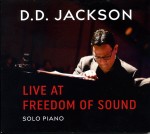 One pianist who doesn’t use post-production and overdubbing is Canadian D.D. Jackson, whose Live at Freedom of Sound (ddjackson.com) is exactly as advertised. It features the Ottawa native improvising on his own compositions plus one by his mentor, the late Don Pullen. Jackson’s tunes include ones like Tunnel Vision, which marry a waterfall of glissandi to a bluesy backbeat. Becoming both soulful and sophisticated, it surges ahead while leaving room for strident plinking detours. Or the pieces can be lyrical and soothing, as the Pullen-memorial For Don, which makes its points through squirming amoeba-like jabs that culminate in an implicit feeling of melancholy. Some motifs sound instantly familiar, but are sweet without being cloying. Even jaunty, demonstrative D.D.’s Bounce/Better Angels, with its foot-patting exposition at the finale, includes a middle section where pressurized single-note emphasis leaves no doubt about cerebral toughness. But perhaps the most telling track is Richard’s Tune, which Pullen composed in honour of another influential pianist, Muhal Richard Abrams. A solid synthesis of almost pre-modern chording and melodic suggestions, the waltz-time tune maintains a contemporary feel by sliding low-pitched percussive jumps in the midst of its gently rhythmic storytelling. At the same time, Jackson’s high-quality and unique interpretation confirms his place in the jazz lineage that includes Pullen and Abrams.
One pianist who doesn’t use post-production and overdubbing is Canadian D.D. Jackson, whose Live at Freedom of Sound (ddjackson.com) is exactly as advertised. It features the Ottawa native improvising on his own compositions plus one by his mentor, the late Don Pullen. Jackson’s tunes include ones like Tunnel Vision, which marry a waterfall of glissandi to a bluesy backbeat. Becoming both soulful and sophisticated, it surges ahead while leaving room for strident plinking detours. Or the pieces can be lyrical and soothing, as the Pullen-memorial For Don, which makes its points through squirming amoeba-like jabs that culminate in an implicit feeling of melancholy. Some motifs sound instantly familiar, but are sweet without being cloying. Even jaunty, demonstrative D.D.’s Bounce/Better Angels, with its foot-patting exposition at the finale, includes a middle section where pressurized single-note emphasis leaves no doubt about cerebral toughness. But perhaps the most telling track is Richard’s Tune, which Pullen composed in honour of another influential pianist, Muhal Richard Abrams. A solid synthesis of almost pre-modern chording and melodic suggestions, the waltz-time tune maintains a contemporary feel by sliding low-pitched percussive jumps in the midst of its gently rhythmic storytelling. At the same time, Jackson’s high-quality and unique interpretation confirms his place in the jazz lineage that includes Pullen and Abrams.
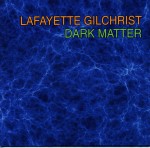 Jackson’s initial stateside notice came when he spent time as pianist in saxophonist David Murray’s group. For the past decade and a half, Baltimore’s Lafayette Gilchrist has filled that chair and Dark Matter (CDcds 005 lafayettegilchristmusic.com) is an 11-track live showcase of his playing and compositional skills. Although Gilchrist apprenticed playing a Washington, D.C, hip-hop variant called go-go, what this did was strengthened his vernacular soloing. For example, For the Go-Go, which opens this set, is an out-and-out swinger with downward key splatters and single-note variables. But the showy rhythms expressed owe as much to stride strategies as the go-go beat. Likewise And You Know This, which supposedly merges Jamaican ska with New Orleans funk, ingeniously highlights both genres’ blues roots with the common Spanish tinge by intensifying the backbeat through left-handed pressure, key fanning and theme variations. While some tracks may be showy, the keyboard sleight of hands is never gratuitous and his playing is buttery and affectionate as well as tough and steely. Gilchrist also creates quiet themes that wouldn’t be out of place on an Errol Garner date and logically interpolates song fragments into his sequences. Could that be It Ain’t Necessarily So within Dark Matter? He’s also capable of updating a traditional blues, as on Blues for Our Marches to End by adding a Black Lives Matter-suggestive title to the tune’s expected walking-bass line, which is more broadly amplified by the end. Meantime, Spontaneous Combustion showcases shifting time signatures and pitches with detours into ragtime-like flourishes and built-up hip-hop allusions. High-frequency rollicking, splintered tones and dissected patterns connect by the finale.
Jackson’s initial stateside notice came when he spent time as pianist in saxophonist David Murray’s group. For the past decade and a half, Baltimore’s Lafayette Gilchrist has filled that chair and Dark Matter (CDcds 005 lafayettegilchristmusic.com) is an 11-track live showcase of his playing and compositional skills. Although Gilchrist apprenticed playing a Washington, D.C, hip-hop variant called go-go, what this did was strengthened his vernacular soloing. For example, For the Go-Go, which opens this set, is an out-and-out swinger with downward key splatters and single-note variables. But the showy rhythms expressed owe as much to stride strategies as the go-go beat. Likewise And You Know This, which supposedly merges Jamaican ska with New Orleans funk, ingeniously highlights both genres’ blues roots with the common Spanish tinge by intensifying the backbeat through left-handed pressure, key fanning and theme variations. While some tracks may be showy, the keyboard sleight of hands is never gratuitous and his playing is buttery and affectionate as well as tough and steely. Gilchrist also creates quiet themes that wouldn’t be out of place on an Errol Garner date and logically interpolates song fragments into his sequences. Could that be It Ain’t Necessarily So within Dark Matter? He’s also capable of updating a traditional blues, as on Blues for Our Marches to End by adding a Black Lives Matter-suggestive title to the tune’s expected walking-bass line, which is more broadly amplified by the end. Meantime, Spontaneous Combustion showcases shifting time signatures and pitches with detours into ragtime-like flourishes and built-up hip-hop allusions. High-frequency rollicking, splintered tones and dissected patterns connect by the finale.
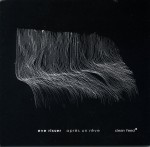 If the one criticism levelled at Dark Matter is that it needs more of an edge, that sentiment couldn’t be applied to the next disc. Using a prepared upright piano, France’s Eve Risser explores all the crannies and parameters of her composition Après un rêve (Clean Feed CF 524 CD cleanfeedrecords.com) during its nearly 25-minute duration. Stopping and exciting the internal strings so that they vibrate guitar-like and create a clanking percussive continuum, she adds keyboard patterning to devise a distinctive quasi-impressionistic exposition. After the narrative picks up Latin inflections, the occasional single note fill that sneaks out is examined every which way before returning to the assemblage. Echoes and variables connect so well that by the three-quarter mark two-handed manoeuvres create an intense performance that is sometimes so percussive it could be the sounds of a keyboardist and a drummer. After adding top-side chording and internal rumbles, swift glissandi finally mark a descending individual key-plinking ending.
If the one criticism levelled at Dark Matter is that it needs more of an edge, that sentiment couldn’t be applied to the next disc. Using a prepared upright piano, France’s Eve Risser explores all the crannies and parameters of her composition Après un rêve (Clean Feed CF 524 CD cleanfeedrecords.com) during its nearly 25-minute duration. Stopping and exciting the internal strings so that they vibrate guitar-like and create a clanking percussive continuum, she adds keyboard patterning to devise a distinctive quasi-impressionistic exposition. After the narrative picks up Latin inflections, the occasional single note fill that sneaks out is examined every which way before returning to the assemblage. Echoes and variables connect so well that by the three-quarter mark two-handed manoeuvres create an intense performance that is sometimes so percussive it could be the sounds of a keyboardist and a drummer. After adding top-side chording and internal rumbles, swift glissandi finally mark a descending individual key-plinking ending.
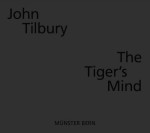 Creating an equally atonal program at more than twice the length as Risser’s is British pianist John Tilbury, who on The Tiger’s Mind (Cubus Records CR 372 cubus-records.ch), presents an improvisation based on parts of Cornelius Cardew’s notated score. A longtime Cardew associate and his biographer, Tilbury’s familiarity with the material allows him to add snatches of clamour and cries from pre-recorded fire, water and bird sounds to the performance, as well as utilize the spatial properties of the cathedral in which he recorded. Initially using the pedals to emphasize the piano’s stentorian tones, Tilbury’s aleatory variations soon move to higher pitches. These include singular string plucks and pauses, as well as patterns which subtly incorporate bell-pealing and aviary caws. As the interpretation strengthens, lapping water suggestions and sea lion-like yelps briefly disrupt the cascading narrative. After a strident whistle signals the midway point, the narrative continues to unroll fluidly with thematic material sharing space with wood echoes from the piano’s bottom board and sides, plus vibrations along tightly wound strings. Just when it seems as if the piece will evaporate into silence, a final sequence unleashes jangling metallic string preparations that presage horizontal passages that establish a defining finale.
Creating an equally atonal program at more than twice the length as Risser’s is British pianist John Tilbury, who on The Tiger’s Mind (Cubus Records CR 372 cubus-records.ch), presents an improvisation based on parts of Cornelius Cardew’s notated score. A longtime Cardew associate and his biographer, Tilbury’s familiarity with the material allows him to add snatches of clamour and cries from pre-recorded fire, water and bird sounds to the performance, as well as utilize the spatial properties of the cathedral in which he recorded. Initially using the pedals to emphasize the piano’s stentorian tones, Tilbury’s aleatory variations soon move to higher pitches. These include singular string plucks and pauses, as well as patterns which subtly incorporate bell-pealing and aviary caws. As the interpretation strengthens, lapping water suggestions and sea lion-like yelps briefly disrupt the cascading narrative. After a strident whistle signals the midway point, the narrative continues to unroll fluidly with thematic material sharing space with wood echoes from the piano’s bottom board and sides, plus vibrations along tightly wound strings. Just when it seems as if the piece will evaporate into silence, a final sequence unleashes jangling metallic string preparations that presage horizontal passages that establish a defining finale.
Combining inspiration with their own skills, each pianist shows how impressively and distinctively the multi-keyed mini-orchestra can be used to create a memorable program.
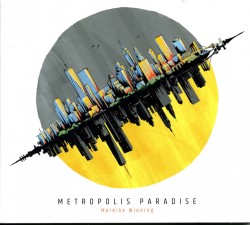 Metropolis Paradis
Metropolis Paradis






